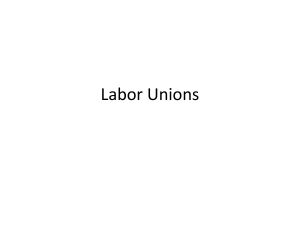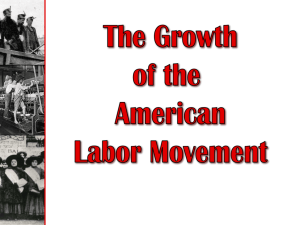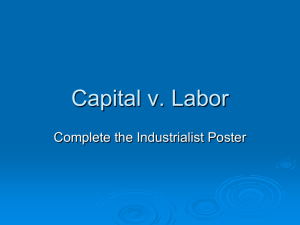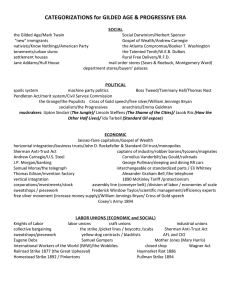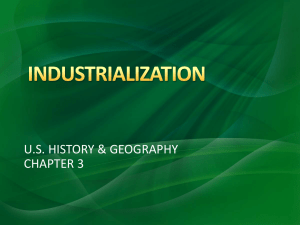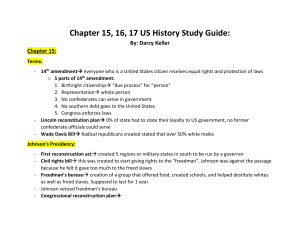Labor in the 1890s
advertisement
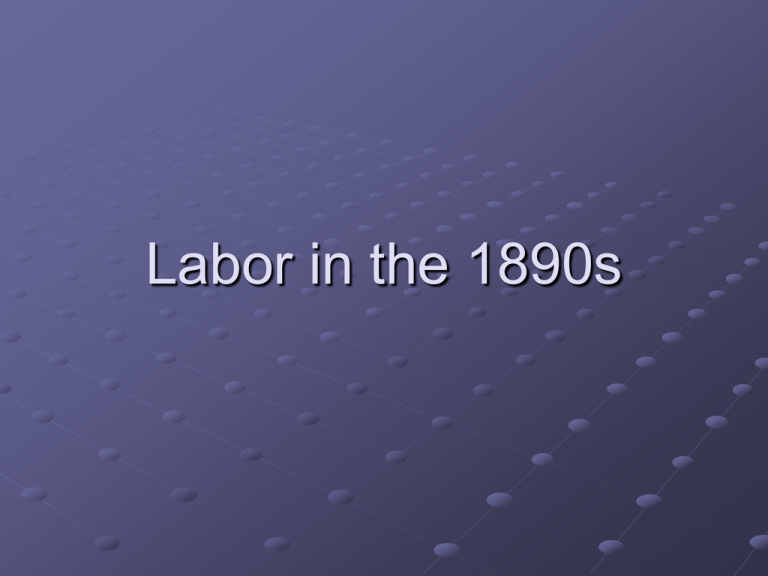
Labor in the 1890s Widening gulf between rich and poor 1890 – richest 9% held 75% of the nation’s wealth Average working family made only a few hundred dollars/year Necessary for most members of working class families to work in order to survive Wealthy lived very well and ostentatiously Socialism A political and economic theory of collective government ownership of factories and property Goal – a fair distribution of wealth and equality Never a strong movement in U.S. Karl Marx Criticized the capitalist economic system and predicted its eventual overthrow by the workers American Reaction to Socialism Contrary to American ideals of free enterprise and private property Most Americans did not support However – growing discontent existed among the working class Union movement was an alternative Early Unions Organized by trade Helped members in hard times Became a voice for demands for shorter workdays, higher wages, and better conditions Knights of Labor Early – national union Willing to organize virtually all working men and women – farmers, factory workers, white collar workers – included African Americans President – Terence Powderly Goals: Equal pay for equal work – 8 hour day – an end to child labor American Federation of Labor Samuel Gompers – President Ignored politics – concentrated on strong organizations of each skill Organization – Loose confederation of craft unions – organization of each skill Philosophy – workers as a group had more power than working individually Goals of AFL Bread and Butter Issues – wages, hours, and working conditions Collective bargaining – workers negotiate as a group with the employer Closed shop – Wanted a shop that employed only Federation members Friction between Labor and Management Measures taken to stop unions – forbid union meetings and fire union organizers “Yellow Dog” Contracts – promise not to join the union or to participate in a strike – new workers were forced to sign these Great Railroad Strike of 1877 Baltimore and Ohio RR Cause: RR cut wages 10% and ran “double headers” (long trains with 2 engines) as a means to cut workers Reaction to wage cuts spread through Pennsylvania to Ohio and the Midwest Riot in Pittsburgh – state militia called in – 10 people killed – strikers fought back and set fire to railroad cars and buildings Results of the RR Strike President Hayes sent federal troops to put down the strike Precedent set: From 1877 on employers relied on state and federal troops to repress labor unrest Haymarket 1886 Company: McCormick Reaper in Chicago Cause: Workers wanted an 8 hour day – called for a strike. Strikebreakers (scabs) were brought in and there was a fight. The police broke up the fight and several people were injured. A protest rally was called by anarchists. Rally at Haymarket Rally at Haymarket A bomb was thrown 7 policemen were killed and many wounded Police opened fire on the crowd There were dozens of deaths Results of Haymarket 8 anarchists convicted of conspiracy Bomb thrower never found 4 anarchists hung 1 committed suicide 3 pardoned by Governor Altgeld Homestead Strike - 1892 Company: Carnegie Steel – Homestead, PA Cause: The Union of Steel and Iron Workers had negotiated a labor contract with Carnegie Steel Carnegie went to Europe Carnegie’s partner – Frick – cut wages The union went on strike What Happened? Frick called in the Pinkertons (police force to break strikes) The strikers fired on the Pinkertons An anarchist – Alexander Berkman – tried to assassinate Frick The governor called in state troops to end the violence The union acknowledged defeat The Battle at Homestead Pullman Strike - 1894 Company – Pullman Sleeping Cars of Chicago Pullman built a company town – owned all of the houses and shops Depression – Pullman cut wages and did not reduce rents A team of workers went to Pullman to protest and he fired them The workers went out on strike Pullman Strike Pullman refused to negotiate and shut down the plant The American Railway Union refused to handle any trains that hauled the Pullman Car This became a national rail strike which disrupted the western rail traffic including the mail More Pullman Attorney General Richard Olney argued that the mail had to go through and the union was in violation of the Sherman Antitrust Act Olney got a court order to end the strike Union president – Eugene Debs refused the order and went to jail President sent in U.S. troops and 12 strikers were killed Precedents From 1877 on – employers relied on state and federal troops to repress labor unrest People associated unions with the rising tide of labor violence Factory owners could get court orders against unions as combinations in restraint of trade and deny unions recognition as legally protected organizations
